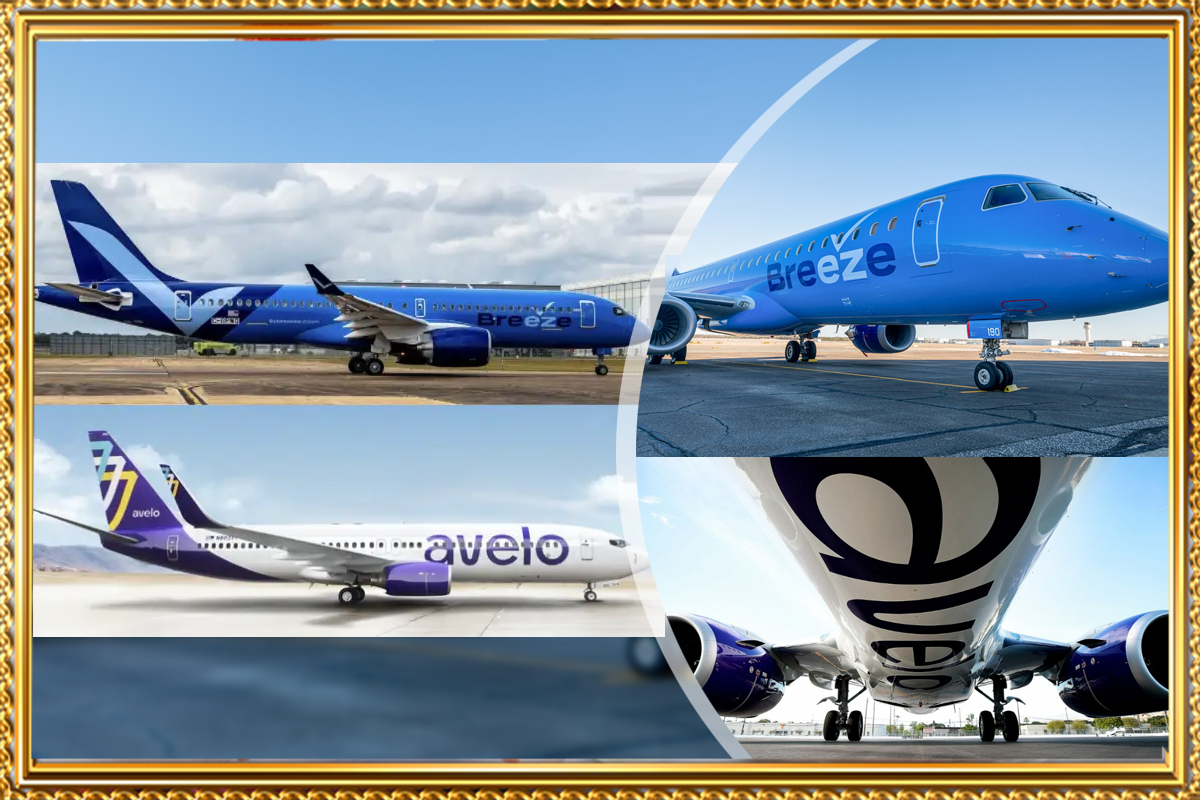- Home
- How Avelo & Breeze Airways Are Adapting Post-Pandemic
How Avelo & Breeze Airways Are Adapting Post-Pandemic

A deep dive into the challenges Avelo Airlines and Breeze Airways have faced since their launch during the pandemic, along with their strategies, competitive advantages, and potential future growth.
The airline industry has undergone significant shifts since the pandemic, with new entrants like Avelo Airlines and Breeze Airways attempting to carve out their niche. While both airlines launched with ambitious goals of providing affordable travel options to underserved markets, they have faced numerous challenges that have shaped their operations. This article explores the struggles and successes of these two low-cost carriers and their impact on the airline industry.
Challenges Faced by Avelo and Breeze Airways
Competitive Advantages of Avelo and Breeze Airways
Industry Context & Market Dynamics
Technology & Innovation
Competitive Pressures & Responses
Customer Experience & Service Enhancements
Strategic Partnerships & Alliances
Challenges in Regulatory Compliance & Growth
Positive Aspects of Avelo and Breeze Airways
Negative Aspects of Avelo and Breeze Airways
FAQs
CONCLUSION
Challenges Faced by Avelo and Breeze Airways
- 1. Operational and Financial Struggles One of the primary challenges both airlines have faced is financial sustainability. Since launching during the pandemic, they have had to navigate fluctuating demand, rising fuel prices, and intense competition from established carriers. • Avelo Airlines had to scale back operations in multiple cities, including Redding, CA, and Fort Collins, CO, due to lower-than-expected passenger loads and operational costs. • Breeze Airways struggled with maintaining profitability on certain routes, leading to service reductions and strategy shifts. 2. Airport Infrastructure and Partnerships Operating from smaller, secondary airports comes with benefits like lower fees, but it also presents challenges: • Limited infrastructure can result in reduced flight frequency. • Dependence on third-party ground service providers, as seen in Avelo's departure from Redding due to the loss of Trego-Dugan Aviation. 3. Consumer Awareness and Brand Loyalty Unlike major airlines with decades of reputation, Avelo and Breeze have had to build brand recognition from scratch. Competing for customers against industry giants like Southwest and Delta has proven challenging. 4. Pilot and Crew Shortages A nationwide shortage of pilots and crew has impacted airline operations, leading to scheduling challenges and higher labor costs.

Competitive Advantages of Avelo and Breeze Airways
Despite these challenges, both airlines have implemented strategies to stay competitive:
- 1. Lower Fares & Cost Structure • Avelo and Breeze operate with a low-cost model, allowing them to offer competitive fares compared to legacy airlines. • They avoid major hubs, reducing airport fees and congestion-related delays. 2. Unique Route Networks • Avelo focuses on point-to-point travel between underserved markets, avoiding the need for layovers. • Breeze Airways emphasizes flexible scheduling with routes that traditional airlines have ignored. 3. Fleet and Technology • Breeze uses the modern Airbus A220, which offers better fuel efficiency and a comfortable passenger experience. • Avelo operates a fleet of Boeing 737s, which allows for a simplified maintenance and training process.
Industry Context & Market Dynamics
- • Post-Pandemic Travel Recovery: How Avelo and Breeze adapted to shifting passenger demand as air travel rebounded from COVID-19. • Changing Consumer Preferences: More travelers prioritize affordability and direct flights over premium services. • Impact of Inflation & Rising Costs: Increasing fuel prices, airport fees, and labor costs affecting their operational sustainability.
Technology & Innovation
- • Digital-First Approach: Both airlines leverage mobile bookings, self-check-in, and minimal physical infrastructure to keep costs low. • AI & Data-Driven Operations: Use of AI for dynamic pricing, route optimization, and demand forecasting. • Sustainability Efforts: Any moves toward eco-friendly practices, such as fleet modernization and fuel efficiency strategies.
Competitive Pressures & Responses
- • Rivalry with Low-Cost Giants: Competition from Southwest, Spirit, and Frontier, which have more established networks and brand loyalty. • Ultra-Low-Cost Carrier Challenges: The fine balance between offering ultra-low fares and maintaining profitability. • Expansion Plans: Future cities/routes being considered and strategies for gaining a foothold in new markets.
Customer Experience & Service Enhancements
- • Passenger Satisfaction & Feedback: Reviews and testimonials regarding pricing, comfort, and reliability. • Loyalty Programs & Customer Retention: Whether Avelo and Breeze have introduced or plan to introduce reward programs. • Handling of Cancellations & Delays: How they manage passenger disruptions compared to major airlines.
Strategic Partnerships & Alliances
- • Codeshare Agreements or Alliances: Potential collaborations with regional or international carriers to expand reach. • Corporate Travel & Group Bookings: Whether they are targeting business travelers or groups with tailored fare structures.
Challenges in Regulatory Compliance & Growth
- • FAA Regulations & Compliance Costs: Challenges in meeting evolving safety and operational regulations. • Airport Slot Availability: Difficulty in securing optimal time slots at major airports if expansion is pursued. • Financial Backing & Long-Term Stability: Analysis of funding sources and investor confidence in their sustainability.
Positive Aspects of Avelo and Breeze Airways
- • Affordable Travel: Both airlines have significantly lowered the cost of air travel for many underserved cities. • Convenience: Non-stop flights to secondary airports reduce travel time and congestion compared to major hubs. • Flexibility: Breeze Airways offers a unique "Nice, Nicer, Nicest" fare structure, allowing passengers to choose their level of comfort.
Negative Aspects of Avelo and Breeze Airways
- • Limited Routes: Since they serve niche markets, many travelers may not find routes that match their needs. • Service Reductions: Both airlines have discontinued multiple routes due to low demand and operational challenges. • Inconsistent Scheduling: With limited fleets, cancellations or rescheduling can be more common compared to legacy airlines.
FAQs
- 1. Why did Avelo Airlines leave Redding, California? Avelo exited Redding due to the loss of its ground service partner and low passenger loads, making the route financially unsustainable. 2. How do Avelo and Breeze Airways compare to legacy airlines? They offer lower fares and direct routes to secondary airports but have limited flight frequency and fewer amenities compared to major carriers. 3. What are the biggest challenges for new low-cost airlines? Financial sustainability, infrastructure limitations, staffing shortages, and brand recognition are key challenges. 4. Will Avelo and Breeze continue to grow? If they can optimize their route networks and manage operational costs, they have the potential to expand in the coming years.
Background of Avelo and Breeze Airways: Avelo Airlines launched in April 2021, positioning itself as an ultra-low-cost carrier (ULCC) focused on secondary airports to reduce operational costs. Breeze Airways, founded by JetBlue’s David Neeleman, also debuted in 2021 with a goal of offering affordable, point-to-point travel between mid-sized U.S. cities. Both airlines aimed to disrupt the market by offering non-stop services on routes that were either underserved or previously abandoned by major carriers.
Future Outlook: While Avelo and Breeze Airways have faced significant hurdles, they continue to refine their business models. Breeze is expanding its fleet with more A220 aircraft, while Avelo is concentrating on improving operational efficiency and route viability. As the travel industry recovers, these airlines may find success by maintaining affordability and targeting underserved routes. Whether they can establish long-term sustainability remains to be seen.

Conclusion: Avelo Airlines and Breeze Airways represent a new wave of low-cost carriers aiming to reshape air travel. While they have faced financial and operational challenges, their innovative business models continue to offer affordable and convenient options for travelers. The next few years will be critical in determining their long-term success in the competitive airline industry.
0 Comments
Top Rated Adventure
Where to Find the Best Holiday Decorations and Free Tours in Washington D.C.
- 25 Nov 2024
- 0 0


















Post a comment